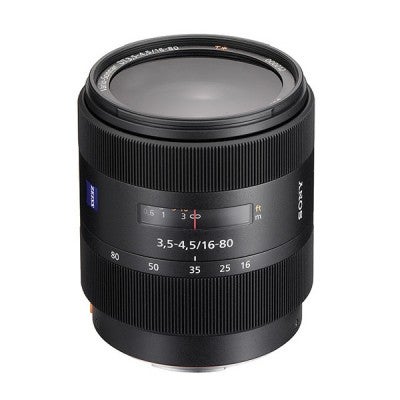Review of the Sony Carl Zeiss DT 16-80mm f3.5-4.5 ZA lens
Sony Carl Zeiss DT 16-80mm f3.5-4.5 ZA Review
First, the 16-80mm’s MTF curves now have a textbook appearance. Maximum resolution is in excess of 0.3 cycles per pixel from wide-open to f/11 at all focal lengths and the fall-off at smaller apertures is nicely progressive. Any resolution performance above 0.25 cycles per pixel indicates a well-mannered lens and this lens exceeds such expectations. Second, chromatic aberration is all but invisible. It is true that taxing images (bare tree branches silhouetted against a bright sky) reveal colour fringes when examined at pixel-level but this manner of inspection is so severe that no standard zoom can escape totally unblemished.
Third, optical distortion is well controlled. There is significant barrel distortion (6.3%) at 16mm, falling to an insignificant level (0.1%) at 35mm, then switching to a small amount of pincushioning (0.6%) at 80mm. That said, even when set to its minimum focal length the lens produces a natural image quality in which distortion is not obtrusive. Equally pleasant is the way depth-of-field is rendered: there is a particularly soft gradation from in-focus to out-of-focus regions despite biting sharpness in the former. This trick is something of a Carl Zeiss speciality and is one of the best reasons for choosing this lens over Sony’s own lenses.
Handling is good thanks to a wide zoom ring closest to the camera body and a narrower manual-focus ring beyond. The zoom mechanism produces a continuous extension in the lens as it progresses from 16 to 80mm. There is a focused-distance window but no indications for depth-of-field.
It might be thought unfortunate that the maximum aperture is only f/3.5 and that this declines to f/4.5 at 80mm when other standard zooms achieve and even maintain a maximum aperture of f/2.8. But the 16-80mm has a 5x zoom, which is more than most of its rivals offer. The only lens that triumphs on both counts is the Olympus 12-60mm f/2.8-4 but that retails at over £600.
IMAGE QUALITY
(Below) There is a beautifully natural graduation from sharpness to out-of-focus blur when the lens is used wide-open (in this case at its 16mm focal length).







